2023 TOYOTA 86 warning
[x] Cancel search: warningPage 190 of 449
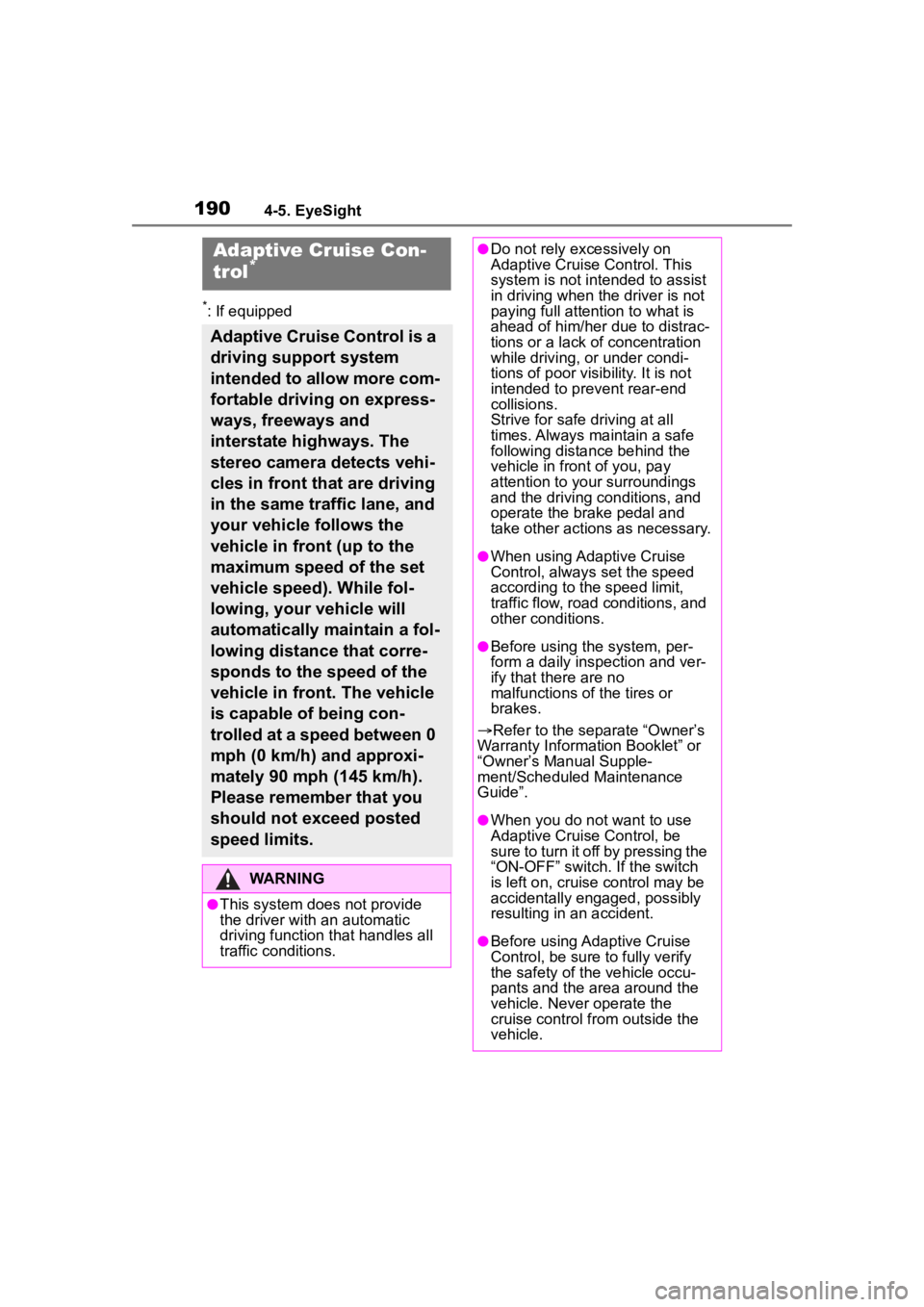
1904-5. EyeSight
*: If equipped
Adaptive Cruise Con-
trol*
Adaptive Cruise Control is a
driving support system
intended to allow more com-
fortable driving on express-
ways, freeways and
interstate highways. The
stereo camera detects vehi-
cles in front that are driving
in the same traffic lane, and
your vehicle follows the
vehicle in front (up to the
maximum speed of the set
vehicle speed). While fol-
lowing, your vehicle will
automatically maintain a fol-
lowing distance that corre-
sponds to the speed of the
vehicle in front. The vehicle
is capable of being con-
trolled at a speed between 0
mph (0 km/h) and approxi-
mately 90 mph (145 km/h).
Please remember that you
should not exceed posted
speed limits.
WARNING
●This system does not provide
the driver with an automatic
driving function that handles all
traffic conditions.
●Do not rely excessively on
Adaptive Cruise Control. This
system is not intended to assist
in driving when the driver is not
paying full attention to what is
ahead of him/her due to distrac-
tions or a lack of concentration
while driving, or under condi-
tions of poor visibility. It is not
intended to prevent rear-end
collisions.
Strive for safe driving at all
times. Always maintain a safe
following distance behind the
vehicle in front of you, pay
attention to your surroundings
and the driving conditions, and
operate the brake pedal and
take other actions as necessary.
●When using Adaptive Cruise
Control, always set the speed
according to the speed limit,
traffic flow, road conditions, and
other conditions.
●Before using t he system, per-
form a daily inspection and ver-
ify that there are no
malfunctions of the tires or
brakes.
Refer to the separate “Owner’s
Warranty Informat ion Booklet” or
“Owner’s Manual Supple-
ment/Scheduled Maintenance
Guide”.
●When you do not want to use
Adaptive Cruise Control, be
sure to turn it off by pressing the
“ON-OFF” switch. If the switch
is left on, cruise control may be
accidentally engaged, possibly
resulting in an accident.
●Before using Adaptive Cruise
Control, be sure to fully verify
the safety of the vehicle occu-
pants and the area around the
vehicle. Never operate the
cruise control from outside the
vehicle.
Page 191 of 449
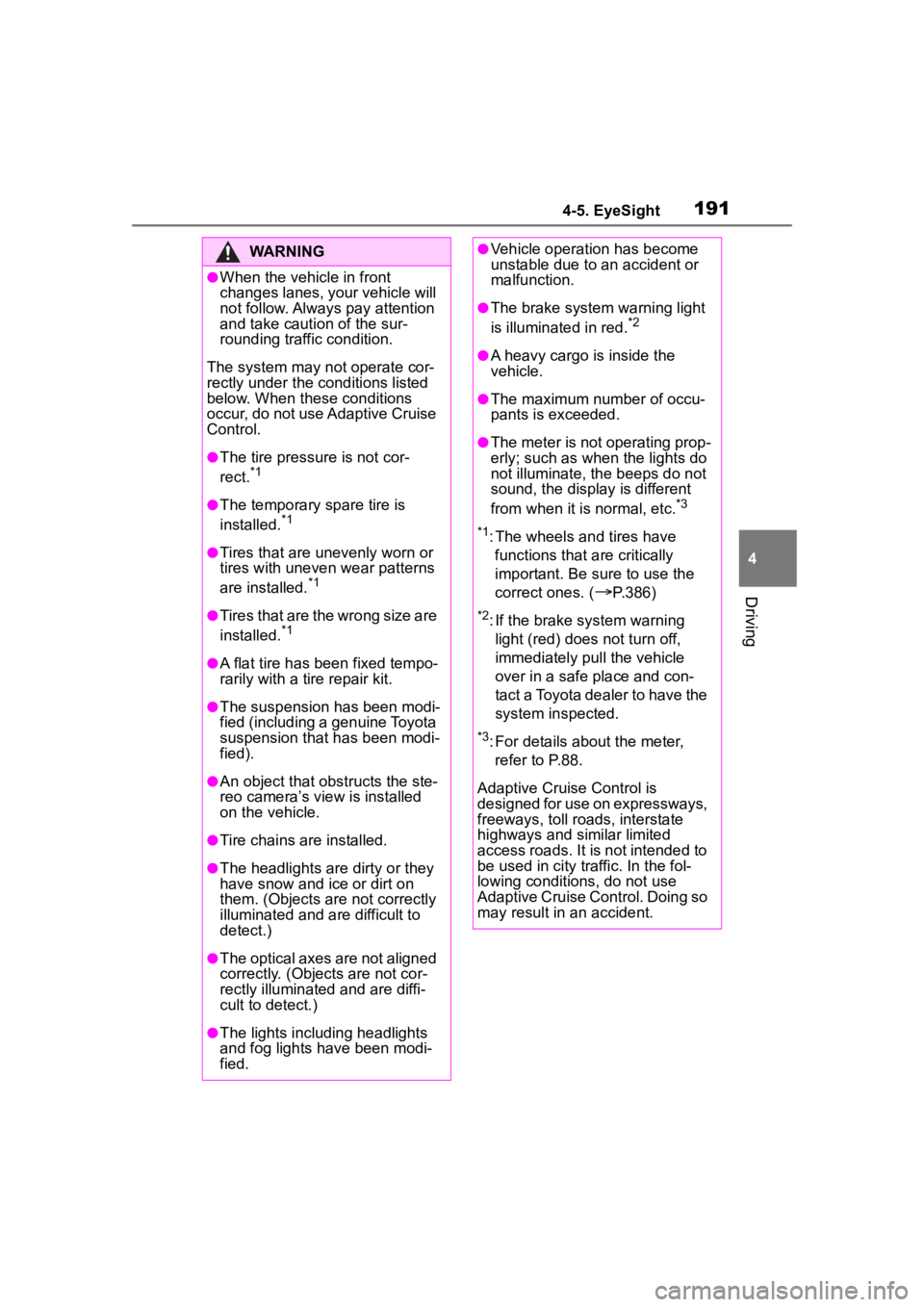
1914-5. EyeSight
4
Driving
WARNING
●When the vehicle in front
changes lanes, your vehicle will
not follow. Always pay attention
and take caution of the sur-
rounding traffic condition.
The system may not operate cor-
rectly under the c onditions listed
below. When these conditions
occur, do not use Adaptive Cruise
Control.
●The tire pressure is not cor-
rect.*1
●The temporary spare tire is
installed.*1
●Tires that are u nevenly worn or
tires with uneven wear patterns
are installed.
*1
●Tires that are the wrong size are
installed.*1
●A flat tire has been fixed tempo-
rarily with a tire repair kit.
●The suspension has been modi-
fied (including a genuine Toyota
suspension that has been modi-
fied).
●An object that obstructs the ste-
reo camera’s view is installed
on the vehicle.
●Tire chains are installed.
●The headlights are dirty or they
have snow and ice or dirt on
them. (Objects are not correctly
illuminated and are difficult to
detect.)
●The optical axes are not aligned
correctly. (Objects are not cor-
rectly illuminate d and are diffi-
cult to detect.)
●The lights including headlights
and fog lights have been modi-
fied.
●Vehicle operation has become
unstable due to an accident or
malfunction.
●The brake system warning light
is illuminated in red.*2
●A heavy cargo is inside the
vehicle.
●The maximum number of occu-
pants is exceeded.
●The meter is not operating prop-
erly; such as when the lights do
not illuminate, the beeps do not
sound, the display is different
from when it is normal, etc.
*3
*1
: The wheels and tires have functions that are critically
important. Be sure to use the
correct ones. (
P.386)
*2: If the brake s ystem warning
light (red) does not turn off,
immediately pull the vehicle
over in a safe place and con-
tact a Toyota dealer to have the
system inspected.
*3: For details about the meter, refer to P.88.
Adaptive Cruise Control is
designed for use on expressways,
freeways, toll roads, interstate
highways and similar limited
access roads. It is not intended to
be used in city traffic. In the fol-
lowing conditions, do not use
Adaptive Cruise Control. Doing so
may result in an accident.
Page 192 of 449

1924-5. EyeSight
WARNING
●Ordinary roads (roads other
than those mentioned above)
• Depending on the driving envi- ronment (complexity of roads
and other factors), the system
may not be able to perform as
the traffic conditions require,
and that may result in an acci-
dent.
●Sharp curves or winding roads
●Frozen roads, snow-covered
roads or other slippery road sur-
faces
• The tires may spin, causing loss of control of the vehicle.
●Traffic conditions when fre-
quent acceleration and deceler-
ation make it difficult to maintain
the following distance
• It may not be po ssible for the
system to perform as the traffic
conditions require.
●Steep downhill grades
• The set vehicle speed may be exceeded.
●On a steep continuous downhill
grade
• The brakes may overheat.
●Roads and overpasses with
repeated steep uphill and down-
hill grades
• Detection of the vehicle in front may be lost, or the road surface
may be detected instead of the
vehicle in front, making correct
control impossible.
●Entering a sharp curve/turn into
an interchange or junction, or a
service area, parking area, toll
booth or other facilities
• Detection of the vehicle in front may not be possible.
●There are changes in bright-
ness, such as at a tunnel
entrance or exit.
Page 193 of 449
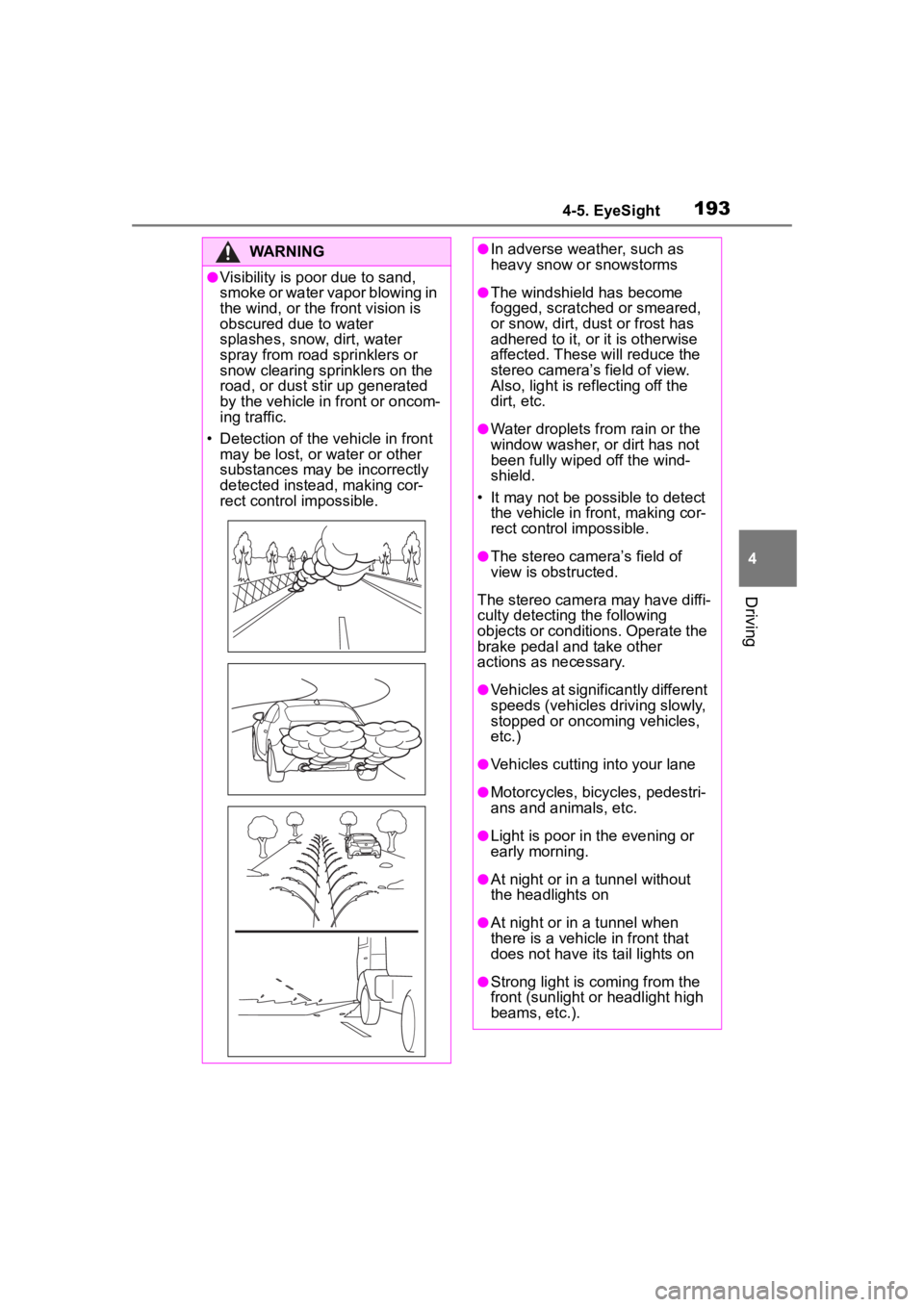
1934-5. EyeSight
4
Driving
WARNING
●Visibility is poor due to sand,
smoke or water vapor blowing in
the wind, or the front vision is
obscured due to water
splashes, snow, dirt, water
spray from road sprinklers or
snow clearing sprinklers on the
road, or dust stir up generated
by the vehicle in front or oncom-
ing traffic.
• Detection of the vehicle in front may be lost, or water or other
substances may be incorrectly
detected instead, making cor-
rect control impossible.
●In adverse weather, such as
heavy snow or snowstorms
●The windshield has become
fogged, scratched or smeared,
or snow, dirt, dust or frost has
adhered to it, or it is otherwise
affected. These will reduce the
stereo camera’s field of view.
Also, light is reflecting off the
dirt, etc.
●Water droplets from rain or the
window washer, or dirt has not
been fully wiped off the wind-
shield.
• It may not be possible to detect the vehicle in front, making cor-
rect control impossible.
●The stereo camer a’s field of
view is obstructed.
The stereo camera may have diffi-
culty detecting the following
objects or conditions. Operate the
brake pedal and take other
actions as necessary.
●Vehicles at significantly different
speeds (vehicles driving slowly,
stopped or oncoming vehicles,
etc.)
●Vehicles cutting into your lane
●Motorcycles, bicycles, pedestri-
ans and animals, etc.
●Light is poor in the evening or
early morning.
●At night or in a tunnel without
the headlights on
●At night or in a tunnel when
there is a vehicle in front that
does not have its tail lights on
●Strong light is coming from the
front (sunlight or headlight high
beams, etc.).
Page 194 of 449

1944-5. EyeSight
WARNING
●Vehicles in front that have a rear
aspect that is low, small or irreg-
ular (the system may recognize
another part of the vehicle and
will determine operation from
that)
• An empty truck or trailer that has no tailgate or longbed
• Vehicles that have cargo pro- truding from their back ends
• Non-standard shaped vehicles (vehicle transporters or vehi-
cles with a sidecar fitted, etc.)
• Vehicles that are low
●Objects that are located close to
the bumper of your vehicle
■Detection of the vehicle in
front by the EyeSight stereo
camera
*
●Under the follo wing road condi-
tions or conditions of your vehi-
cle, detection o f the vehicle in
front may not be possible. Vehi-
cles in neighboring traffic lanes
or roadside objects may also be
incorrectly dete cted. Under con-
ditions such as these, do not
use Adaptive Cruise Control. If
cruise control is currently in use,
operate the brake pedal and
take other actions as necessary.
• Following begins from a short following distance, such as
when the vehicle in front is a
vehicle that cut into your lane.
• On curved roads, at the start and end of a curve and on
roads with continuous curves
(These conditions make it diffi-
cult for the system to detect
vehicles because they are out-
side the detectable area.)
• On an on-ramp or off-ramp to a freeway, highway, or other
restricted access road (Eye-
Sight Adaptive Cruise Control is
not designed for use in this kind
of driving environment.)
• In an urban or suburban envi- ronment (Adaptive Cruise Con-
trol is not appropr iate for use in
these driving areas. Use Adap-
tive Cruise Control only on lim-
ited-access highways.)
Page 195 of 449

1954-5. EyeSight
4
Driving
WARNING
�
Page 198 of 449
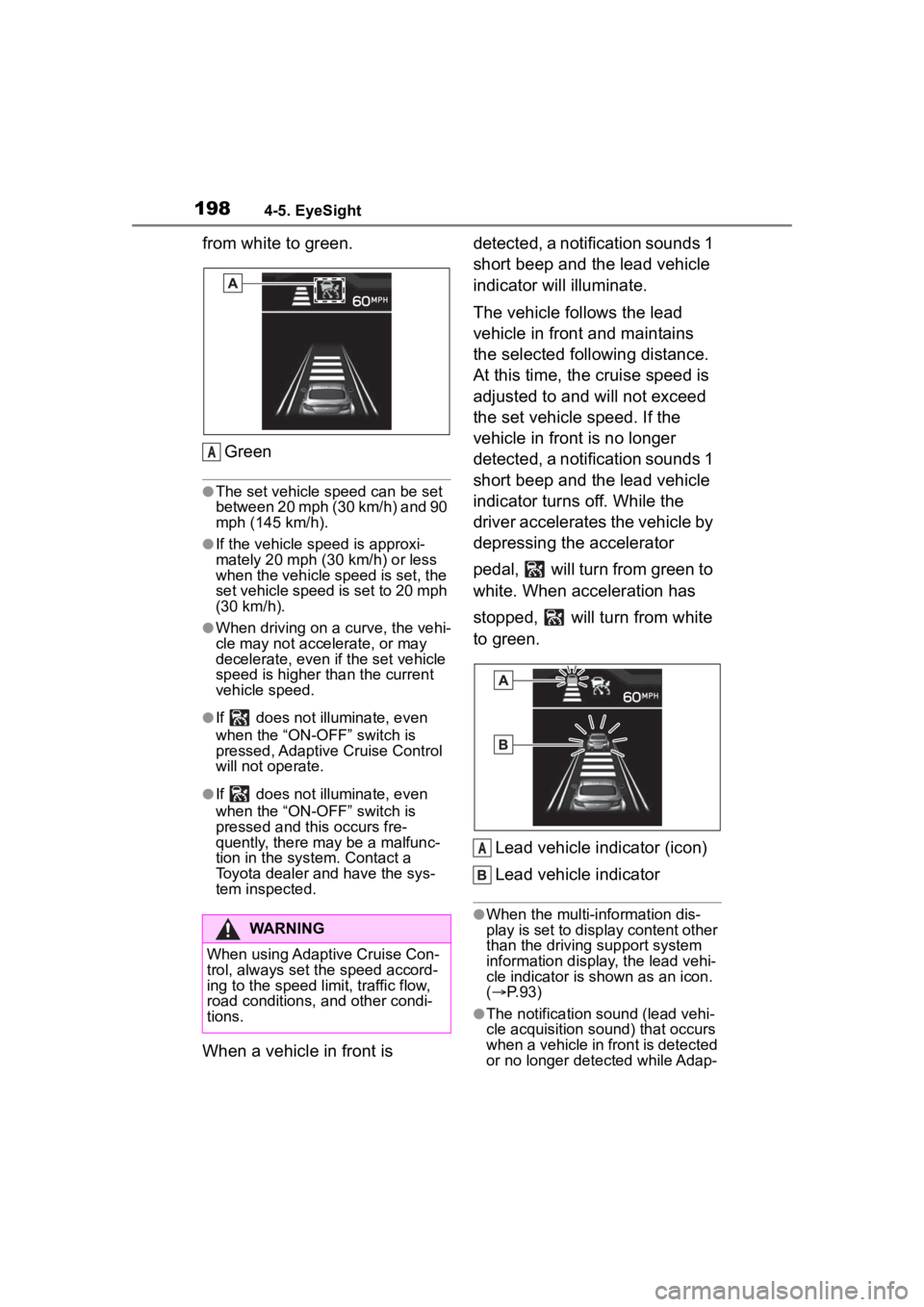
1984-5. EyeSight
from white to green.Green
●The set vehicle speed can be set
between 20 mph (30 km/h) and 90
mph (145 km/h).
●If the vehicle speed is approxi-
mately 20 mph ( 30 km/h) or less
when the vehicle speed is set, the
set vehicle speed is set to 20 mph
(30 km/h).
●When driving on a curve, the vehi-
cle may not acce lerate, or may
decelerate, even if the set vehicle
speed is higher than the current
vehicle speed.
●If does not illu minate, even
when the “ON-OFF” switch is
pressed, Adaptive Cruise Control
will not operate.
●If does not illu minate, even
when the “ON-OFF” switch is
pressed and this occurs fre-
quently, there may be a malfunc-
tion in the system. Contact a
Toyota dealer and have the sys-
tem inspected.
When a vehicle in front is detected, a notification sounds 1
short beep and the lead vehicle
indicator will illuminate.
The vehicle follows the lead
vehicle in front and maintains
the selected following distance.
At this time, the cruise speed is
adjusted to and will not exceed
the set vehicle speed. If the
vehicle in front is no longer
detected, a notification sounds 1
short beep and the lead vehicle
indicator turns off. While the
driver accelerates the vehicle by
depressing the accelerator
pedal, will turn from green to
white. When acceleration has
stopped, will turn from white
to green.
Lead vehicle indicator (icon)
Lead vehicle indicator
●When the multi-information dis-
play is set to display content other
than the driving support system
information display, the lead vehi-
cle indicator is shown as an icon.
( P. 9 3 )
●The notification sound (lead vehi-
cle acquisition sound) that occurs
when a vehicle in front is detected
or no longer detected while Adap-
WARNING
When using Adaptive Cruise Con-
trol, always set the speed accord-
ing to the speed limit, traffic flow,
road conditions, and other condi-
tions.
A
A
Page 201 of 449
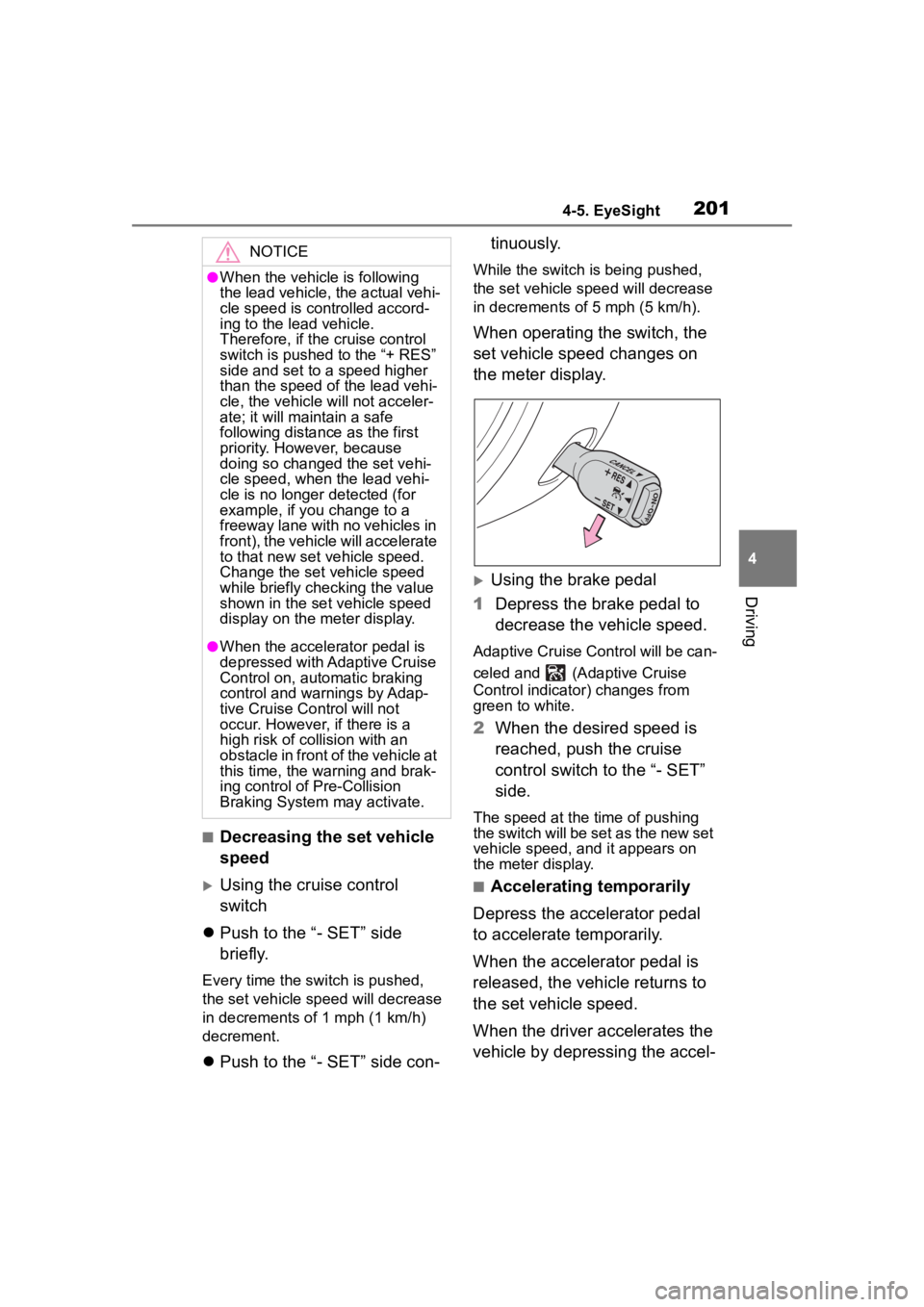
2014-5. EyeSight
4
Driving
■Decreasing the set vehicle
speed
Using the cruise control
switch
Push to the “- SET” side
briefly.
Every time the switch is pushed,
the set vehicle speed will decrease
in decrements o f 1 mph (1 km/h)
decrement.
Push to the “- SET” side con- tinuously.
While the switch is being pushed,
the set vehicle spee
d will decrease
in decrements of 5 mph (5 km/h).
When operating the switch, the
set vehicle speed changes on
the meter display.
Using the brake pedal
1 Depress the brake pedal to
decrease the vehicle speed.
Adaptive Cruise Control will be can-
celed and (Adaptive Cruise
Control indicator) changes from
green to white.
2When the desired speed is
reached, push the cruise
control switch to the “- SET”
side.
The speed at the time of pushing
the switch will be set as the new set
vehicle speed, and it appears on
the meter display.
■Accelerating temporarily
Depress the accelerator pedal
to accelerate temporarily.
When the accelerator pedal is
released, the vehicle returns to
the set vehicle speed.
When the driver accelerates the
vehicle by depressing the accel-
NOTICE
●When the vehicle is following
the lead vehicle, the actual vehi-
cle speed is controlled accord-
ing to the lead vehicle.
Therefore, if the cruise control
switch is pushed to the “+ RES”
side and set to a speed higher
than the speed of the lead vehi-
cle, the vehicle will not acceler-
ate; it will maintain a safe
following distance as the first
priority. However, because
doing so changed the set vehi-
cle speed, when the lead vehi-
cle is no longer detected (for
example, if you change to a
freeway lane with no vehicles in
front), the vehicle will accelerate
to that new set vehicle speed.
Change the set vehicle speed
while briefly checking the value
shown in the set vehicle speed
display on the meter display.
●When the accelerator pedal is
depressed with Adaptive Cruise
Control on, automatic braking
control and warnings by Adap-
tive Cruise Control will not
occur. However, if there is a
high risk of collision with an
obstacle in front of the vehicle at
this time, the warning and brak-
ing control o f Pre-Collision
Braking System may activate.